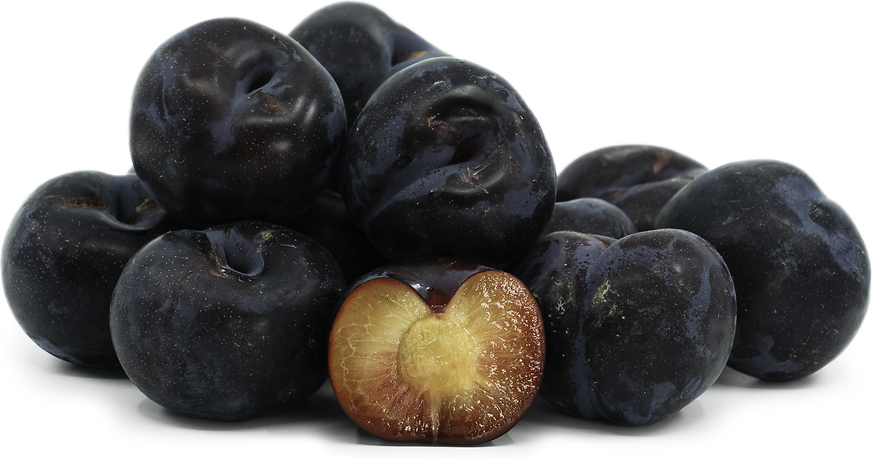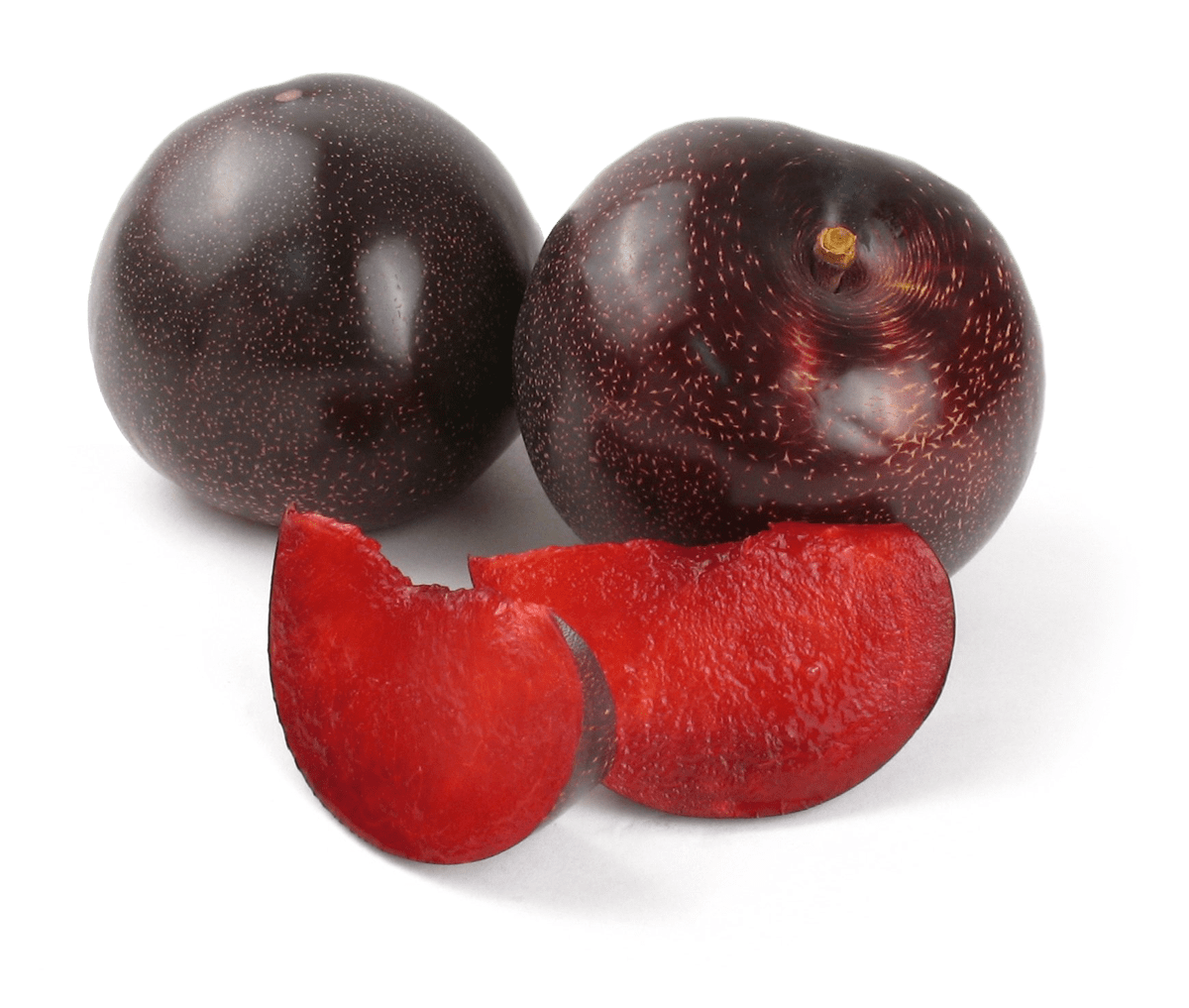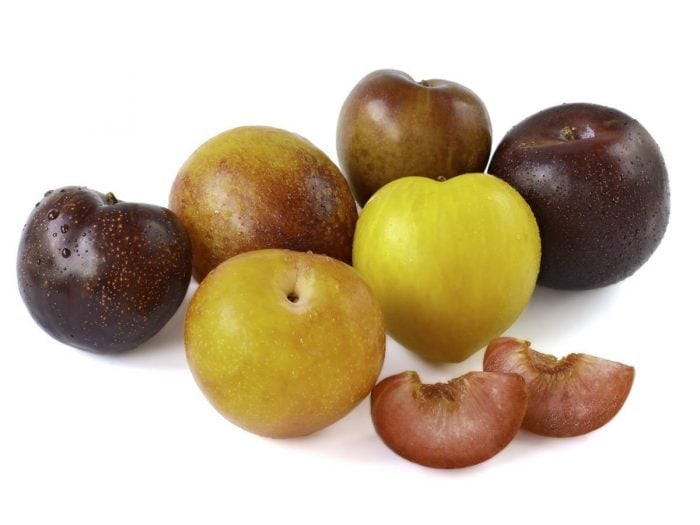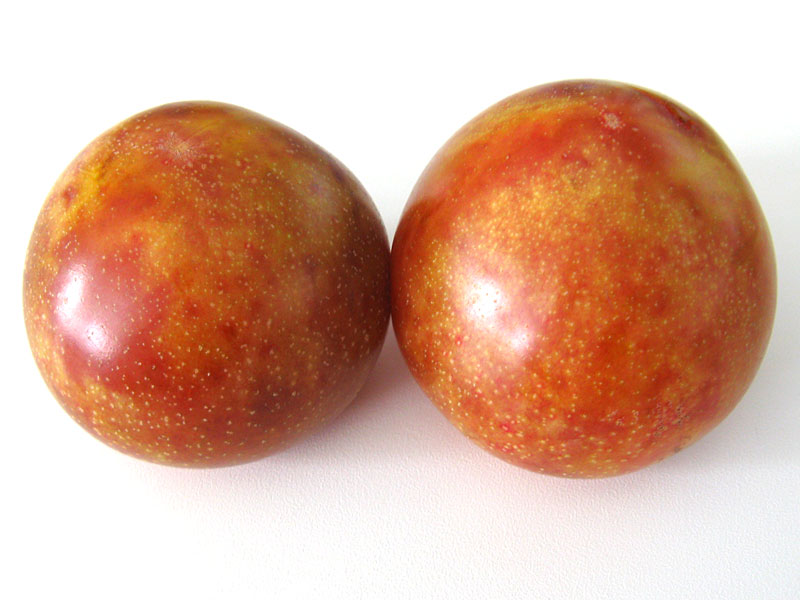Types of Plums and Pluots, Plus Everything Plum
:max_bytes(150000):strip_icc()/Sweet-Treat-Plucots-588bc7c95f9b5874eebb4d1b.jpg)
Types of Plums and Pluots, Plus Everything Plum
Pluots grow much like plums, on small trees that reach 16 to 36 feet tall and spread up to 10 feet wide without pruning. They are perennials with shallow roots. Pluots have oblong green leaves with a pointed tip, while some varieties have purple leaves. In the spring season, clusters of flower buds sprout from tree branches.
:max_bytes(150000):strip_icc()/Moyer-Plums-588bc7793df78caebcaba6e2.jpg)
Types of Plums and Pluots, Plus Everything Plum
Pluot Nutrition Facts. Two pluots (5oz) provide 80 calories, 1g of protein, 19g of carbohydrates, and 0g of fat. Pluots are a good source of potassium, fiber, and vitamin C. The USDA does not provide specific nutrition facts for pluots. (Under the heading of pluots, the nutritional data is for plumcots, which are 50% each plum and apricot).
:max_bytes(150000):strip_icc()/Yellow-Plums-588bc8c73df78caebcabed32.jpg)
Types of Plums and Pluots, Plus Everything Plum
Santa Rosa Plum: This is a very popular pollinator for many pluot varieties. The Santa Rosa plum is known for its reliable and abundant pollen production, making it an excellent choice. Beauty Plum: A good pollinator for early blooming pluot varieties. Beauty plums are early producers and can help ensure effective pollination for compatible.

Flavor Rosa Pluots Information and Facts
Pluots, apriums and plumcots come in a dizzying variety of cultivars, many with colorful names like Flavor Grenade, Dapple Dandy, and King Kong. They can be enjoyed fresh or incorporated into any recipe that calls for plums. Pluots are high in fiber, vitamin C and potassium, making them an excellent choice for a mid-day snack.
:max_bytes(150000):strip_icc()/Black-Plum-588bc7523df78caebcab9d4b.jpg)
Types of Plums and Pluots, Plus Everything Plum
Keeping in mind that plumcots are usually equal parts plum and apricot while pluots lean more toward the plum family, take a look at these popular varieties to consider planting in your own space. Dapple Dandy. The Dapple Dandy Pluot® (Prunus 'Dapple Dandy') is a fun and tasty option for the whole family. This tree is suited for Zones 5 to.

Plumcots Family Tree Farms
Pluot Recipes. Because pluots are mostly comprised of plum DNA, you can use this fruit as a substitute anywhere plums are used from jams and sauces to baked goods and as a filling for pierogies. Keep in mind the flavor is a bit sweeter and the skin is less bitter, and the texture proves closer to an apricot. Pluot Cake or Plum Cake.
:max_bytes(150000):strip_icc()/mirabelles-56a5b4ba5f9b58b7d0de0d02.jpg)
Types of Plums and Pluots, Plus Everything Plum
Pluots are unique, interspecies hybrids, mixing a lot of plum with a lesser amount of apricot genetics. The fruits look like plums and taste like plums but they have a texture more like apricots. The pluot is an "interspecific" hybrid, a complex mix of two species of fruit. It is some 70 percent plum and some 30 percent apricot.

5 Best Benefits of Pluots Organic Facts
Pluot vs. plums. Plums and pluots each have over 20 varietals with variations in size, color, and sweetness. Pluots look a lot like plums but taste much sweeter thanks to the infusion of apricot genes. Both plum and pluot skin is quite smooth. However, pluot flesh is more similar to that of an apricot, thus making them ideal for cooking as they.

Plant a Pluot Now Edible Marin & Wine Country
Let's just get down to brass tacks. The standard rule of (green) thumb for the delicious trio is as follows: Plumcots are a 50-50 hybrid between plums and apricots. Apriums are an apricot and plum hybrid, but are mostly apricot (typically a 75-25 ratio). Pluots are a plum and apricot hybrid, but are mostly plum (typically a 75-25 ratio).
:max_bytes(150000):strip_icc()/Bucket-of-Plums-588bcc4f3df78caebcac2978.jpg)
Types of Plums and Pluots, Plus Everything Plum
Pluots: How to Select, Store, and Eat the Stone Fruit. Written by MasterClass. Last updated: Dec 21, 2021 • 3 min read. Part plum and part apricot, the pluot is a tasty hybrid fruit with sweet and tart notes, making it perfect for various raw and cooked dishes. Learn how to choose, store, and enjoy pluots. Part plum and part apricot, the.

Pluots = plums pollinated by apricots =>> super sweet, healthy, home
Pluots are a member of the (delicious!) stone fruit family. They are a hybrid fruit developed in the late 80s that are 75% plum and 25% apricot. They resemble plums with smooth skin, and a similar shape and texture. If you've never tasted a pluot you're in for a treat!

Dapple Dandy Pluot® Interspecific Plum — Green Acres Nursery & Supply
Poppy Seed Pound Cake with Plum Pluot Compote. Plums and pluots—a hybrid that blends the color of plums with the flavor and soft texture of apricots—have a natural tartness that flatters the.
:max_bytes(150000):strip_icc()/greengage-plums-56a5b4b85f9b58b7d0de0cff.jpg)
Types of Plums and Pluots, Plus Everything Plum
The texture, flavor and color of pluots are very similar to those of plums. They have smooth skin that can be dark red, dark purple or red with yellow flecks. The skin is glossy and sleek like a plum but the flesh is a bit different. They can have red or yellow flesh, but it's less juicy and not as grainy as plum flesh—it's smooth and consistent.

The Moffin Pluots, Plumcots, & Plumots
Pluots can be eaten fresh out of hand or cooked. Serve quartered or sliced in cream or milk. Slice and add raw to fruit salads. Fill cavities with soft cheese such as Brie. Use firm-ripe plums in poultry or fish salads. Use in fruit compotes, tarts, crisps, and cobblers. Stew for chutney preserves. Use in jams or jellies.
:max_bytes(150000):strip_icc()/Red-Plums-588bc8275f9b5874eebb6881.jpg)
Types of Plums and Pluots, Plus Everything Plum
The strangely named "pluot®" is a hybrid plant grown from a plum and an apricot. Pluots® are extremely sweet, due to very high sugar levels, and are available in a wide range of varieties. The actual ratio works out to around 70% plum and 30% apricot and they mainly look like plums. They have a great deal of nutritious value and are low in.

Plums, pluots eaten fresh or made into jellies
Here are some key differences: Plumcots have a 50-50 blend of plum and apricot genetics. Pluots contain about 75% plum and 25% apricot DNA. Plumcots exhibit more apricot-like traits such as sweet-tart flavor, bright coloring, and tender flesh. Pluots lean more strongly towards plums in taste, texture, and appearance.